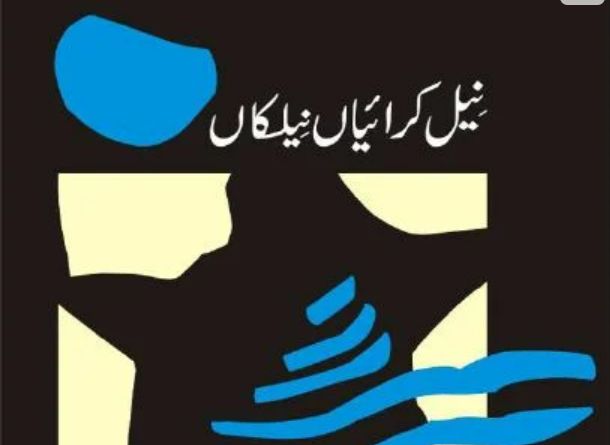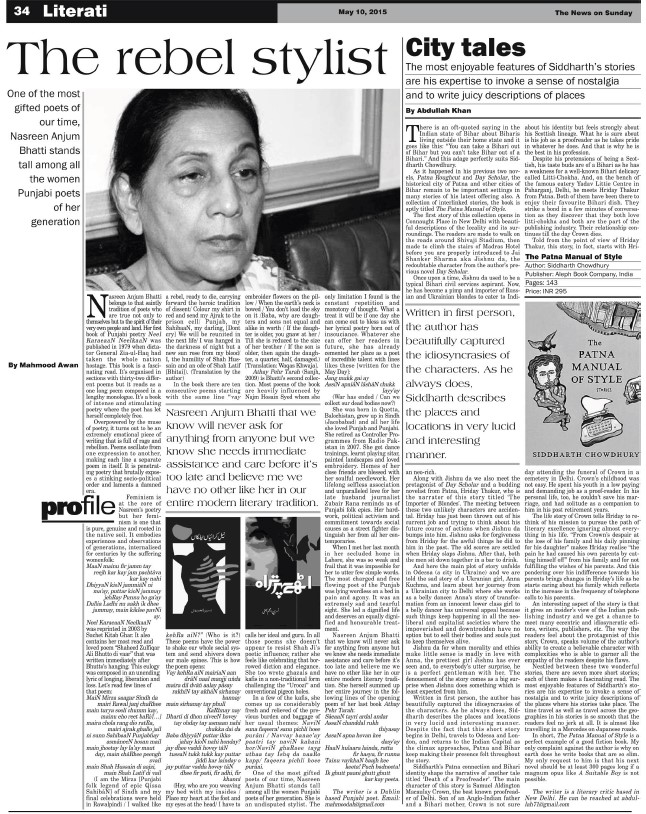Mahmood Awan (The News on Sunday, 10th May 2015)
Nasreen Anjum Bhatti belongs to that saintly tradition of poets who are true not only to themselves but to the spirit of their very own people and land. Her first book of Punjabi poetry Neel KaraeaaN NeelkaaN was published in 1979 when dictator General Zia-ul-Haq had taken the whole nation hostage. This book is a fascinating read. It’s organised in sections with thirty-two different poems but it reads as a one long poem composed in a lengthy monologue. It’s a book of intense and stimulating poetry where the poet has let herself completely free.
Overpowered by the muse of poetry, it turns out to be an extremely emotional piece of writing that is full of rage and rebellion. Poems oscillate from one expression to another, making each line a separate poem in itself. It is penetrating poetry that brutally exposes a stinking socio-political order and laments a damned era.
Feminism is at the core of Nasreen’s poetry but her feminism is one that is pure, genuine and rooted in the native soil. It embodies experiences and observations of generations, internalised for centuries by the suffering womenfolk:
MaaN mainu fir jamm tay reejh kar kay jam pachtãva kar kay nahi
DhiyyaN kioN jammiãN ni ma’ay, puttar kioN jammay jehRay Punnu ho ga’ay
Dullia Ladhi nu aakh ik dhee jammay, main kiklee pavNi ay.
Neel KaraeaaN NeelkaaN was reprinted in 2003 by Suchet Kitab Ghar. It also contains her most read and loved poem “Shaheed Zulfiqar Ali Bhutto di vaar” that was written immediately after Bhutto’s hanging. This eulogy was composed in an unending lyric of longing, liberation and loss. Let’s read few lines of that poem:
MaiN Mirza saagar Sindh da mairi Rawal janj chaRhee
main turya sooli chumm kay, mainu eho reet baRi/[…]
maira chola rang dio ratRa, mairi ajrak ghallo jail
ni sunn SahibaaN Punjabñay asmãneeN hosan mail
main jhootay lay la’ay maut day, main chãRhee peengh svail
main Shah Hussain di aajzi, main Shah Latif di vail
(I am the Mirza [Punjabi folk legend of epic Qissa SahibãN] of Sindh and my final celebrations were held in Rawalpindi / I walked like a rebel, ready to die, carrying forward the heroic tradition of dissent/ Colour my shirt in red and send my Ajrak to the prison cell/ Punjab, my SahibaaN, my darling, [Dont cry] We will be reunited in the next life/ I was hanged in the darkness of night but a new sun rose from my blood/ I, the humility of Shah Hussain and an ode of Shah Latif [Bhitai]). (Translation by the author)
In the book there are ten consecutive poems starting with the same line “vay kehRa aiN?” (Who is it?) These poems have the power to shake our whole social system and send shivers down our male spines. This is how the poem opens:
Vay kehRa aiN mairiaN aan drãN naal manjji uñda
maira dil dvãñ aalay pãsay rakhiN tay akhãN sirhanay bannay
main sirhanay tay phull KaRhnay nay
Dharti di dhon niveeN hovey tay ohday tay asmaan nahi chukka dai da
Baba dhiyyãN puttar ikko jahay kioN nahi honday?
jay dhee vaddi hovey tãN tussaN tukk tukk kay puttar jiddi kar lainday o
jay puttar vadda hovey tãN dhee fir poñi, fir adhi, fir khanni
(Hey, who are you weaving my bed with my insides / Place my heart at the foot and my eyes at the head/ I have to embroider flowers on the pillow / When the earth’s neck is bowed / You don’t load the sky on it /Baba, why are daughters and sons not equal and alike in worth / If the daughter is older, you gnaw at her / Till she is reduced to the size of her brother / If the son is older, then again the daughter, a quarter, half, damaged.) [Translation: Waqas Khwaja].
Athay Pehr Tarah (Sanjh, 2009) is Bhatti’s second collection. Most poems of the book are heavily influenced by Najm Hosain Syed whom she calls her ideal and guru. In all those poems she doesn’t appear to resist Shah Ji’s poetic influence; rather she feels like celebrating that borrowed diction and elegance. She too wrote ghazals and kafis in a non-traditional form challenging the “Uroozi” and conventional pigeon holes.
In a few of the kafis, she comes up as considerably fresh and relieved of the previous burden and baggage of her usual themes: NaviN suna faqeera! sanu pichli hoee purãni / Navvay banae’ay paatri tay naviN kahani hor/NaviN ghaRaee tayg uthaa tay Ishq da naaRo kapp/ faqeera pichli hoee purãni.
One of the most gifted poets of our time, Nasreen Anjum Bhatti stands tall among all the women Punjabi poets of her generation. She is an undisputed stylist. The only limitation I found is the constant repetition and monotony of thought. What a treat it will be if one day she can come out to bless us with her lyrical poetry born out of insouciance. Whatever she can offer her readers in future, she has already cemented her place as a poet of incredible talent with lines likes these [written for the May Day]:
Jang mukk gai ay
AssiN apniãN lãshãN chukk layy’ay
(War has ended / Can we collect our dead bodies now?)
She was born in Quetta, Balochistan, grew up in Sindh (Jacobabad) and all her life she loved Punjab and Punjabi. She retired as Controller Programmes from Radio Pakistan in 2007. She got dance trainings, learnt playing sitar, painted landscapes and loved embroidery. Homes of her close friends are blessed with her soulful needlework. Her lifelong selfless association and unparalleled love for her late husband journalist Zubair Rana reminds us of Punjabi folk epics. Her hardwork, political activism and commitment towards social causes as a street fighter distinguish her from all her contemporaries.
When I met her last month in her secluded home in Lahore, she was so weak and frail that it was impossible for her to utter few simple words. The most charged and free flowing poet of the Punjab was lying wordless on a bed in pain and agony. It was an extremely sad and tearful sight. She led a dignified life and deserves an equally dignified and honourable treatment.
Nasreen Anjum Bhatti that we know will never ask for anything from anyone but we know she needs immediate assistance and care before it’s too late and believe me we have no other like her in our entire modern literary tradition. She herself summed up her entire journey in the following lines of the opening poem of her last book Athay Pehr Tarah:
SãeaaN tayri ardal andar
AssaN chanddal rukh thiyasay
AssaN apna hovan kee dasy’ay
HaaN hulaara lainda, ratta fir hasya, fir runna
Tainu vaykhaN baajh kee keeta! Puch badneeta!
Ik ghutt paani ghutt ghutt kar kay peeta.
Published on 10th May 2015 in The News on Sunday.
https://www.thenews.com.pk/tns/detail/558589-nasreen-anjum-bhatti-rebel-stylist


